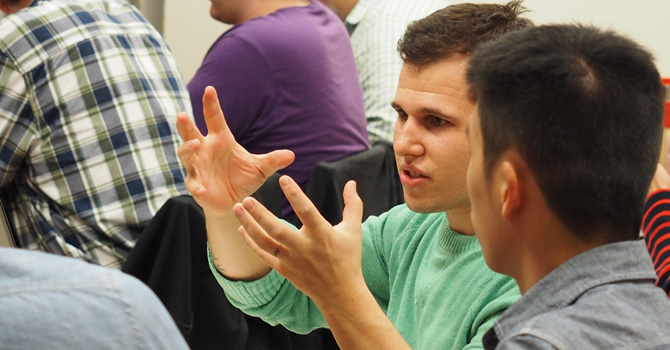Update: Daniel O. Aleshire retired in 2017 as the executive director of The Association of Theological Schools.
When The Association of Theological Schools released a report on enrollment trends over the last five years, the headline was a bit surprising.
“Seminaries set six enrollment records” was the title of the report, which went on to describe the growth trends, including a record number of professional master’s degree students. Another recent report identified 100 seminaries that have grown over the past five years and examined the reasons why.
“The trends described here suggest a brighter future for graduate theological education -- six years out from the recession -- than is often reported,” the enrollment report said.
As executive director of ATS, Daniel O. Aleshire is in a unique position to observe and reflect on the fast-changing landscape of theological education. He spoke to Faith & Leadership about educational trends and what they mean for mainline institutions. The following is an edited transcript.
Q: What do you make of the positive findings of the study?
The total enrollment in all ATS schools has been declining for several years now -- for the last seven or eight years. The statistic of overall decline would lead people to believe that all schools are declining and that all degree programs are declining.
However, within that overall decline, there have been a significant number of schools that have had growing enrollments. And a significant number of degree programs have increasing enrollment.
The story is not just the overall decline.
Q: What do you see as the most significant bright spots?
Forty percent of ATS schools have had increasing enrollment. But the primary learning is that there’s no one set of characteristics that is applicable across these growing schools. They’re growing for different reasons, so there’s not the opportunity to mimic a particular institutional behavior and expect the same institutional result by other schools.
Some of the schools that were growing, for example, were candidates for accreditation. They experienced a jump in enrollment once they attained accredited status.
Other schools have developed new educational programs, and it appears that increases in enrollment are directly related to either new degree programs or new patterns of educational delivery.
Some schools have revamped their admissions process -- the way they are posturing the school, describing its mission, focusing in on a particular constituency -- and for some schools, that appears to be what contributed to their growth.
Q: Degree-seeking students have declined by 3 percent since 2009, but some numbers are rising. Talk a little bit about that.
The master of divinity degree continues to be the program with the most students enrolled, but the enrollment in the M.Div. has been declining, while the enrollment in the professional master’s degrees has been increasing -- in fact, increasing pretty significantly over the last several years.
The professional master’s degrees in the olden days of theological education used to be a degree in religious education or a degree in church music. We now have professional master’s degrees offered in almost 250 different degree titles.
A lot of those are overlapping degree titles (one may have a degree in counseling and another in Christian counseling), but it’s still significant.
There is no one of those programs that’s running away. We don’t have the numbers of enrollment by specific title, but my perception is that the primary growth has come in areas of leadership and areas of counseling, and some in areas of intercultural ministry.
I think that another possible reason for this growth in professional master’s degree program enrollment has been the growth over the last 30 years of evangelical Protestant schools. Many of these schools are related to church bodies that have a more free-church pattern of polity that means there’s not an entity requiring the M.Div. ordination.
For ordination, they can choose the degree that they think best fits where they want to focus in their ministry.
Q: Do you think the trend will continue?
I think that this area will continue to grow, for a couple of reasons. One is that, as you know from your colleague at Duke Mark Chaves, an increasing percentage of American churchgoers are going to larger-membership congregations.
Larger-membership congregations have generally a large staff of ministers, most of whom work in some kind of specialized area. As more and more of these positions emerge, then folks are going to pursue education related to them. That would suggest a continuing increase.
Another suggestion of continuing increase would be in the Roman Catholic community, where a number of these professional degrees are taken either by lay ecclesial ministers or by persons who will be ordained to the permanent diaconate, who will not do the full M.Div.
If you look at where the growth is in the Roman Catholic Church, the growth of persons who work in parishes, it is permanent deacons and lay ecclesial ministers. I think that Roman Catholic tendency will continue to contribute to increases in professional master’s enrollment.
Q: Do they tend to go to Roman Catholic institutions?
Yes. For many of them -- and this also would be true of a lot of staff ministers in larger-membership congregations -- they’re already in the job when they start pursuing theological education.
That’s a very different reality from the older pattern where you had to finish seminary before you were ordained, before you got a call to ministry.
So these professional master’s programs often have a student body of persons who are already in the jobs that will use the knowledge their degree programs are providing to them.
The parallel in higher education is something like the executive MBA.
Q: This brings me to something on my mind, which is flexibility. Do flexible options for taking the degrees contribute to the growth?
Several schools have been permitted by the board of commissioners of the ATS Commission on Accrediting to begin offering a significant amount of their program online. For many of them, that has contributed to enrollment.
There remain many questions about distance learning in theological education, particularly the point of spiritual, professional and personal formation. But the classroom is not the only place where persons are formed for ministry.
ATS, in looking at online programs, looks very carefully at how the congregation or place of ministry is utilized as an educational resource in those online programs.
We have many online programs, for example, where an admission requirement is that the person is employed in a ministry setting at least part time.
There is this focus on the congregation or parish as a community of formation, as well as a focus or concern about how the online learning experience contributes to the formation of the student minister.
Q: So the degree is something that’s integrated into your life or your ministry.
I would say an increasing number of M.Div. students are following the same model. The capacity to drop everything and go to seminary has decreased as the average age of seminarians has increased; 23 percent of all students in ATS degree programs are over 50.
That group is less likely to pull up stakes and move. They will either go to the closest seminary to which they can commute or, if the one that they’re most interested in offers extension or distance learning programs, the more it makes it possible for them to begin working on a degree at that school.
My hunch is that the normative pattern of earning the M.Div. for Protestant students is some kind of commuting relationship to the institution where they’re earning the degree, rather than a living-on-campus relationship.
Q: What are the implications for those traditional, mainline seminaries that have historically focused on the M.Div.?
One thing it means for mainline seminaries is that most of them, if they haven’t already, will need to continue to expand their patterns of educational delivery.
I think that mainline seminaries have been reinventing the way they’re offering their curriculum to make it more accessible. That’s the most important thing for them to do.
I think that there’s enough knowledge about how to do theological education well, both in extension settings and in online settings, that it’s no longer an argument of its being second-class.
It may not be what the school or faculty prefers, but it’s not necessarily a second-class pattern of learning for ministry. There are good ways to do it in each of these patterns.
I think that mainline seminaries will be wise to continue to remain focused on the M.Div., because the percentage of larger-membership churches is lower among mainline than among evangelical Protestants.
Mainline seminaries have significantly more endowment resources than other Protestant seminaries. That means they have more resources for student aid, so they will continue to be able to utilize that resource to attract students who otherwise might not be able to afford a seminary.
I don’t know whether theological enrollments follow a rational-markets pattern or not, but when the Presbyterian Church (U.S.A.) announced there were more candidates seeking ordination to word and sacrament than there were congregations that had identified themselves as open for a first-call pastor, enrollment started to decline.
I don’t know that the call of God operates quite that statistically accurately. But there is a sense that if the number of pastor positions declines, then over time the number of students is going to decline, and that’s going to put a pressure on seminaries.
Q: Although responding to a call isn’t necessarily rational, don’t people have more options in how they pursue that call than they once did?
I think that’s a very important point. We convened a meeting of between 40 and 50 very recent graduates or students in their last semester of their seminary program.
We asked each of them to talk a bit about where they were or hoped to be. About half of them -- and this is all anecdotal -- named the congregational context. The other half of them named everything from working with a nonprofit on human trafficking to dealing with homelessness or hunger or at-risk youth.
But they all talked about it as fulfilling what they had perceived as their call to ministry. It wasn’t that they weren’t going into the ministry; they just had a much broader definition of what ministerial work was.
In a project that ATS and the Auburn Center for the Study of Theological Education contributed to several years ago, even those graduates who, 10 years out, were not involved in stipendiary ministry were very pleased with their theological education.
They didn’t feel like those had been wasted years; those were formative years in their lives that helped them put together their understanding of life and faith.
That was a counterintuitive finding in that project. We thought maybe people who were no longer working in ministry would feel frustrated and resentful that they spent time and money to go to seminary.
But for the most part, there was not a negative reaction. I think it gets to the point that seminary is for many people a place where they kind of come to terms with deep perceptions about faith and life -- who they are and what they feel is their call in life.
Q: What to you are some of the more interesting experiments or innovations in theological education going on now?
We’ve spent more than a decade trying to define and develop capacity with distance learning as it applies to theological education. That is an experiment that seems to be proving successful.
Online education is inviting questions about the role of the congregation as an educational environment. We’ve used the congregation as a place for students to practice what was being learned in courses. Now there are schools that are developing reflection on the learning that’s occurring in the practice of ministry. I think that’s going to be important.
We have a couple of schools that are looking hard at competency-based education. Northwest Baptist Seminary in Canada is working very carefully with its denomination. The denomination has identified a set of competencies it wants from its pastors, and the seminary has been developing an educational program. It doesn’t necessarily accumulate credit hours, but it accumulates demonstrations of competence in each of these specific areas.
There is one more I’ll mention briefly, and that is the emergence of theological education for immigrant groups. ATS now has more seminaries that are primarily Asian-serving than it has historically black theological schools.
These Asian-serving schools are new kinds of educational environments, where the immigrants either brought a denomination with them or formed a denomination once they got to North America and then founded a seminary for the education of their pastors, and for all the reasons that other seminaries have been founded.
The most established one would be LOGOS Evangelical Seminary in southern California, which is a seminary related to the Evangelical Formosan Church.
It’s a very interesting moment in theological education. Theological schools are creatures of both higher education and the church. Both of those worlds are changing dramatically right now. That’s the context in which the future is going to play out.








